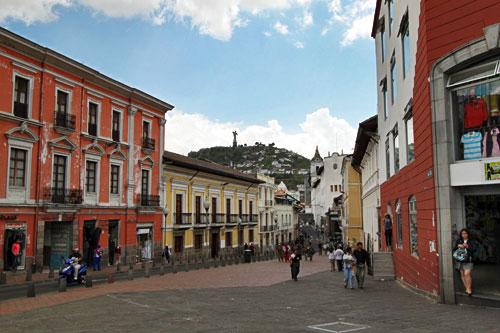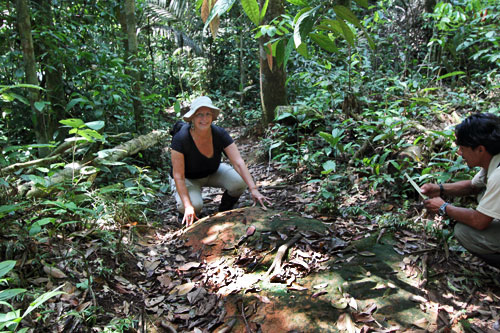Quito enjoys a fair share of fame. Its elevation of 9,200 feet makes it the second highest administrative capital city (after La Paz, Bolivia) and the highest legal capital in the world. It is also the only capital located directly beneath an active volcano, Pichincha, which erupted as recently as 2006, sprinkling ash over the city and disrupting activities, including closure of the international airport. Old town Quito, one of the largest, best-preserved historic districts in the world, was selected by UNESCO as one of the first two World Heritage Sites in 1978. Even its reputation as a dangerous, crime-ridden city imbues it with a certain notoriety. But it was Quito’s distinction as the “Mitad del Mundo” – the Middle of the World – that most fascinated me.

In 1736, French scientists set out to determine the exact point on the globe that was located midway between the north and south poles. This was no easy feat, since so much of “middle earth” is ocean, swamps, and jungle. Their search for dry land led them to Ecuador, a short distance from present day Quito, where they established La Mitad del Mundo (The Middle of the World), also known as the Linea Equatorial or Equator. Two hundred years later, in 1936, a monument was erected on the spot and a line painted on the ground to mark the Equator, a site which is today one of the top tourist destinations in the country.
Each year, thousands of tourists straddle this line, believing they have one foot in the Northern Hemisphere and the other in the Southern Hemisphere. Many have no idea that actual Equator runs through the middle of a pre-Inca ruin located approximately 1,000 feet to the north of the monument, a fact confirmed with the development of satellite Global Positioning Systems (GPS) that allowed for more accurate mathematical calculations.
Can’t view the above slide show of Quito? Click here.
Huffing and puffing from lack of oxygen in Quito’s thin air, I climbed the hilly streets to city parks, visited spectacular Gothic and gilt-covered churches, and wandered around old town on a mission to see every historic building, whether artfully restored or still crumbling. At 11 a.m. on Monday morning I was front and center at the Presidential Palace as Ecuador’s President Correa stepped to the balcony to acknowledge the weekly Changing of the Guard ceremony. But I just couldn’t convince myself to pay admission to visit La Mitad del Mundo, especially since I’d crossed the Equator four times during my cruise around the Galapagos Islands.
Days later I hopped an eastbound bus and descended from the chilly mountaintop to the town of Lago Agrio, gateway to Ecuador’s steamy Amazon jungle. In Cuyabeno National Park I followed my guide down a narrow dirt path bracketed by dense vegetation until he stopped aside a low mound of earth. “You’re standing on the Equator,” he announced.

There was no monument to mark this spot deep in the tropical rainforest, no throngs of noisy tourists. Wild pigs screamed in the distance and birds squawked from hidden treetop perches as I squatted down and reverently touched the middle of the earth – the real Equator.

I loved your post!! About a year ago I spent several weeks in Quito and I still dream about it sometimes. The first few days I was totally lost. But when I finally got a map (I kind of forgot to buy one at home…) and went to “La Mariscal” I found a local tour operator and really had a great time doing a free walking tour and a tour through the historic center. Everyone who has the chance to go to this marvellous city should definitely take it!
You set foot on the ‘true’ equator. I wish I had of done this when I was there in 2010.
I had not idea there are so many inetersting places to visit in Equador! Pretty impressive. This is one good reason to choose it for my next exotic travel destination. Thanks for sharing!
I like how the sun just peaked through the dense leaves right at middle of earth:) Or was it just a reflection of your glow that you had that point all to yourself 🙂 As always, great info and wonderful photos!
I really liked Quito and unlike Guayaquil, I fely perfectly safe wandering the streets (funny what perception does in a place) saying in a fiarly run down but character filled cheap hotel in the old town. The country takes its name from the Equator and I love the idea that all the days of the year, the daylight pretty much runs from 6am to 6pm. Very symmetrical… I think I also remember being told that the Greenwich Meridian line isn’t exactly where it should be either and is off by one or two hunderd metres…
Your article made me think of Sherry refusing to pay to be photographed at the Greenwich Meridian and finding an alternative spot in the streets of Greenwich! Was it local folklore or some scientific measurement that dictated that this particular mound was the equator?
Hi Heather: Nowadays, with GPS, they can easily pinpoint the Equator (or any other spot) on the globe, unlike early explorers who worked with rudimentary measuring instruments. Frankly, it surprises me that they were only 1,000 feet off in Quito.
Reading your article makes me feel like I’ve been to Quito. It is such a lovely place to see and thank you for those good quality pictures because you’ve taken and posted here. I wonder if it’s super hot in that country for it is situated in Ecuador.
Hello Ropes Course: A very good question and one that has me mystified. I knew Ecuador was on the Equator and assumed it would be very hot here. It is, in the Amazon and seasonally on the coast, but elsewhere it’s not, mostly because the cities are at higher elevation. For instance, in Quito it was mid-70’s during the day but down in the 50’s or 60’s at night.